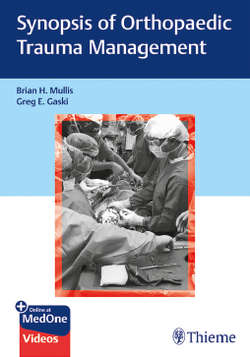Читать книгу Synopsis of Orthopaedic Trauma Management - Brian H. Mullis - Страница 25
На сайте Литреса книга снята с продажи.
V. Soft Tissue Management in Extremity Injuries
ОглавлениеA. Negative pressure wound therapy
1. Negative pressure applied creates unique environment encouraging for wound healing (▶Fig. 2.4).
2. Ideal for soft tissue defects that will heal through secondary intention or require skin grafting.
3. Helpful in the prevention of wound desiccation, reduction of microbial contamination that may occur with dressing changes, and aid in facilitation of wound drainage.
4. Effective way to downscale the complexity of soft tissue reconstruction by promoting granulation tissue.
5. Avoid direct contact with blood vessels, nerves, exposed bone, or tendon without paratenon as it may desiccate or damage these tissues.
6. It will not remove contaminated tissue by itself and basic science data shows it does not lower bacterial counts as much as antibiotic beads.
B. Primary wound closures and skin grafting
1. Open fractures are frequently associated with significant soft-tissue injury and subsequent edema making primary wound closure challenging.
2. Closure should be performed with techniques to preserve the soft tissue integrity and viability.
3. Relaxing incisions adjacent to the wound can be utilized to prevent excessive tension on wound edges when attempting primary closure.
4. Skin grafting is a coverage option for wounds that cannot be closed primarily and have a healthy underlying wound bed of muscle, paratenon, or subcutaneous tissue.
C. Soft tissue flap coverage
Flaps are dictated by the location and size of the soft tissue defect when primary closure is no longer possible. They are indicated for coverage of exposed vital structures including bone, artery, nerve, or tendon without paratenon.
1. Rotational flap coverage:
a. Mobilization of local tissue with its vascular pedicle to an area in need of soft tissue coverage (▶Fig. 2.5).
b. This is a commonly needed option when addressing soft tissue loss in the leg. The local flap of choice is dictated by the defect location.
c. Flap tissue cannot be from an already devitalized area involved in the initial zone of injury.
2. Free tissue transfer:
a. The process of harvesting tissue with its blood supply and relocating it to a different anatomic location through a new vascular anastomosis.
Fig. 2.4 Negative pressure wound therapy is helpful in soft tissue management by reducing microbial contamination between debridements and facilitation of wound drainage.
Fig. 2.5 The gastrocnemius rotational flap is an excellent treatment option for significant soft tissue defects of the proximal tibia.
b. This provides vascularized tissue to the damaged area.
c. Avoids further functional deficits to an already injured area potentially seen in rotational coverage.
3. Timing of soft tissue coverage:
a. Controversy exists regarding the ideal timing of soft tissue coverage with wide variation in practice from center to center.
b. Current recommendations are to attempt to achieve wound coverage within 7 days of the initial injury but the availability of a flap surgeon and need for multiple debridements may make this a very difficult goal to achieve in some situations.
